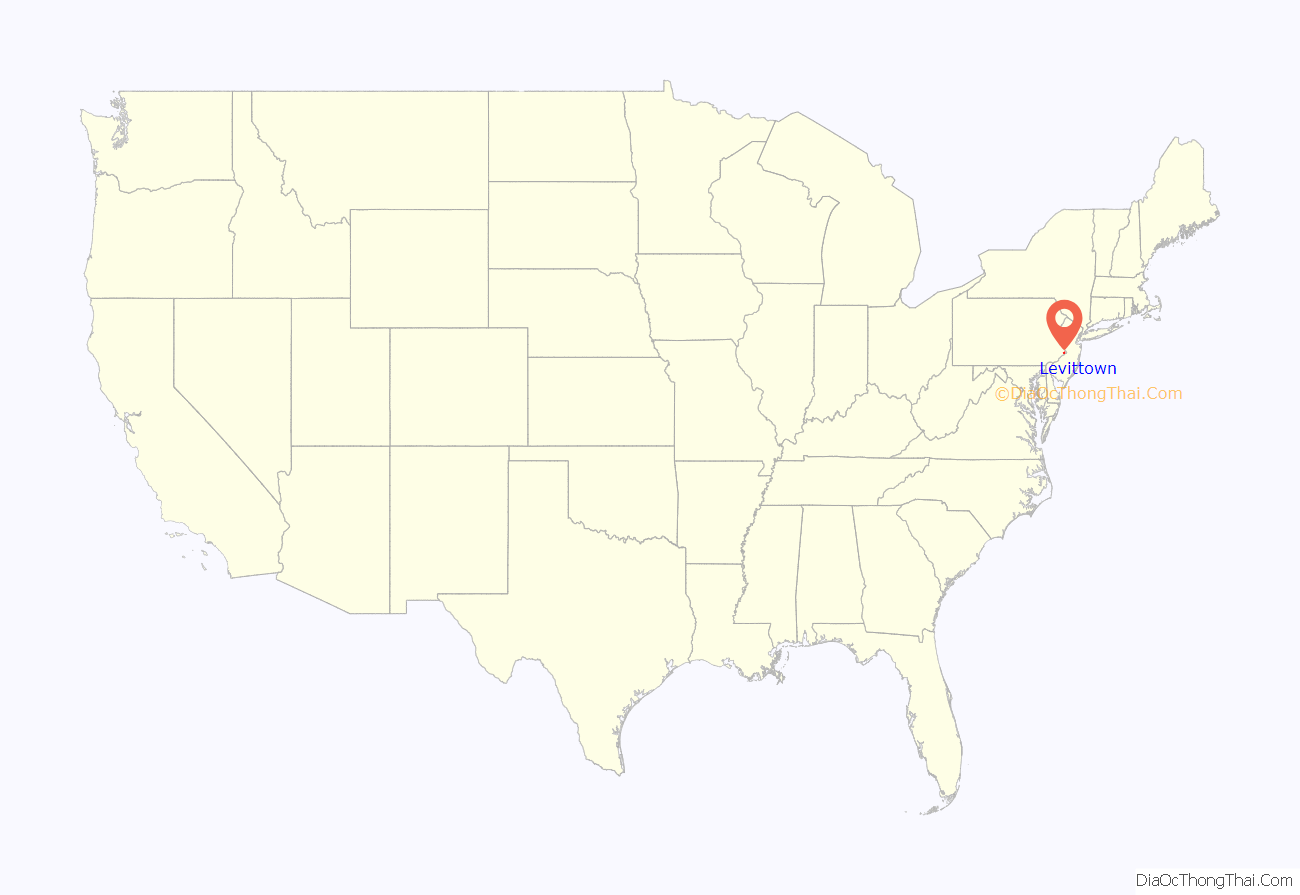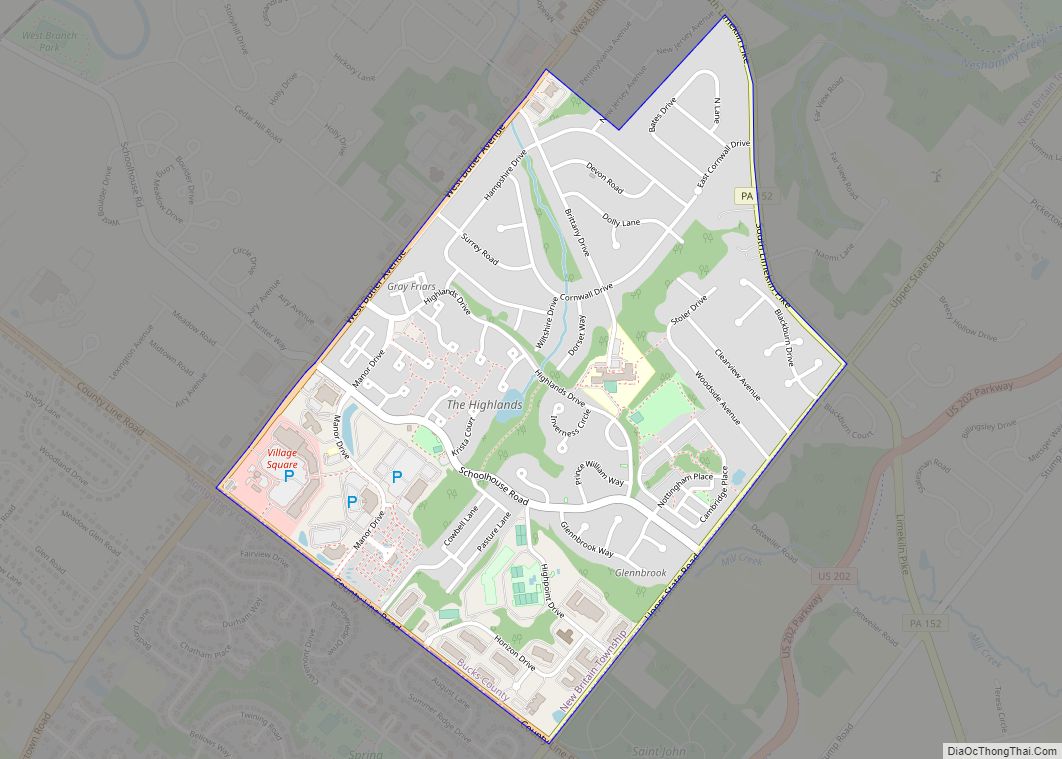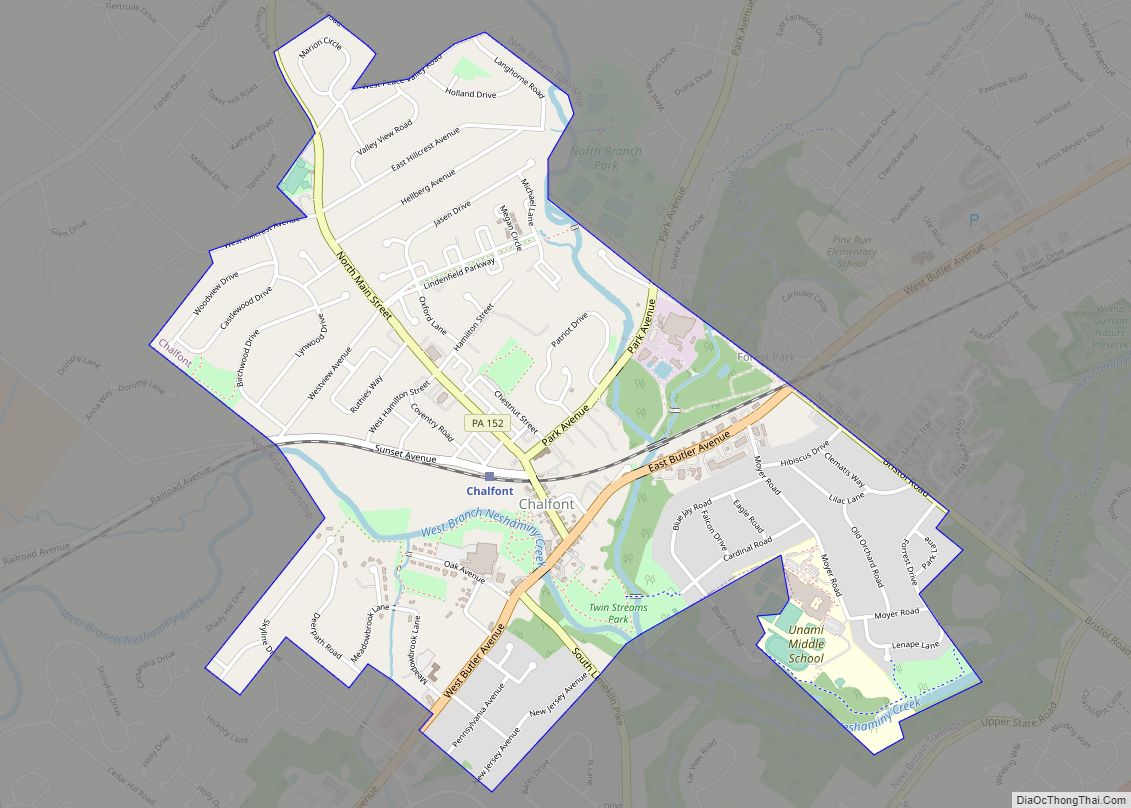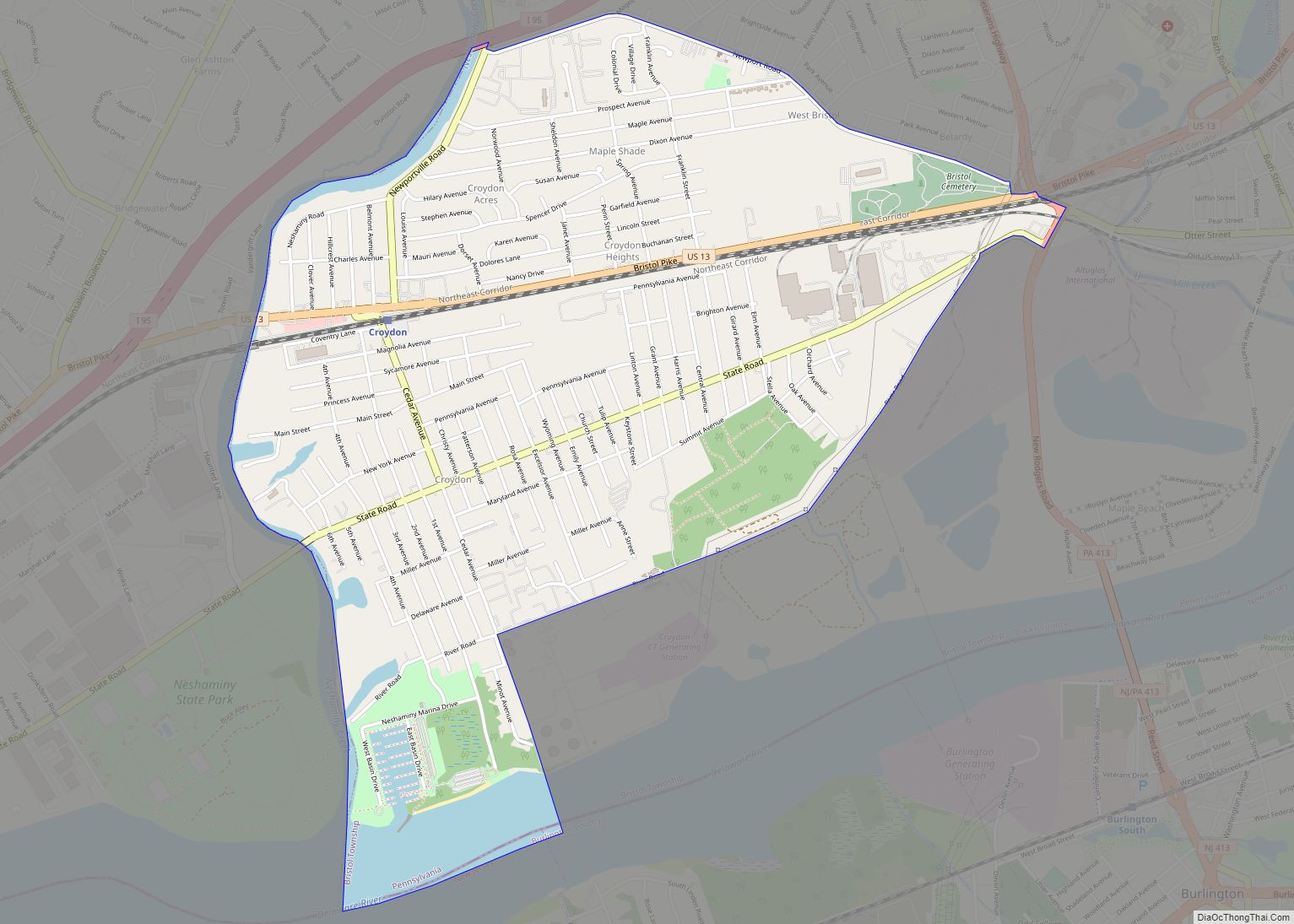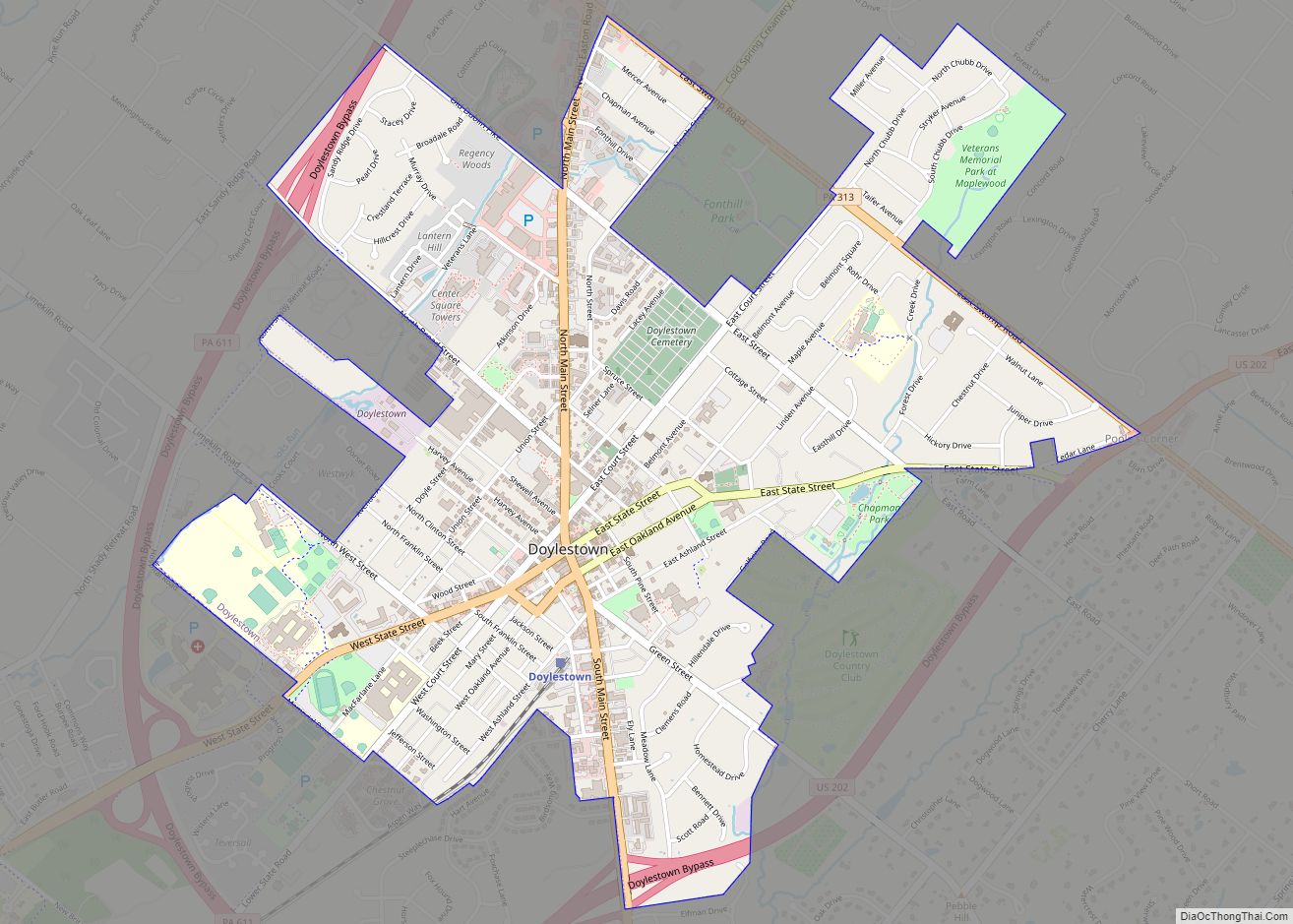Levittown is a census-designated place (CDP) and planned community in Bucks County, Pennsylvania, United States. It is part of the Philadelphia metropolitan area. The population was 52,983 at the 2010 census. It is 40 feet (12 m) above sea level. Though not a municipality, it is sometimes recognized as the largest suburb of Philadelphia (while Upper Darby Township, Lower Merion Township, Bensalem Township, Abington Township and Bristol Township are municipalities larger in size in the three surrounding Pennsylvania counties). Starting with land purchased in 1951, it was planned and built by Levitt & Sons. The brothers William Levitt and architect Alfred Levitt designed its six typical houses.
Levittown is located 72.5 miles (116.7 km) southeast of Allentown and 26.6 miles (42.8 km) northeast of Philadelphia.
| Name: | Levittown CDP |
|---|---|
| LSAD Code: | 57 |
| LSAD Description: | CDP (suffix) |
| State: | Pennsylvania |
| County: | Bucks County |
| Elevation: | 30 ft (9 m) |
| Total Area: | 10.40 sq mi (26.94 km²) |
| Land Area: | 10.30 sq mi (26.68 km²) |
| Water Area: | 0.10 sq mi (0.26 km²) |
| Total Population: | 52,699 |
| Population Density: | 5,116.41/sq mi (1,975.38/km²) |
| FIPS code: | 4242928 |
Online Interactive Map
Click on ![]() to view map in "full screen" mode.
to view map in "full screen" mode.
Levittown location map. Where is Levittown CDP?
History
Most of the land on which Levittown is built was purchased in 1951. Levitt and Sons only built six models of houses in Levittown, all single-family dwellings with lawns: the Levittowner, the Rancher, the Jubilee, the Pennsylvanian, the Colonial and the Country Clubber, with only modest exterior variations within each model. The homes were moderately priced and required only a low down payment. Construction of Levittown began in February 1952, soon after completion of Levittown, New York, located on Long Island. Levittown, Pennsylvania, was the second “Levittown” built by William J. Levitt, who is often credited as the creator of the modern American suburb. To speed up construction, Levitt & Sons perfected a 26-step rationalized building method that was essentially an assembly line type of home building. The house remained stationary, while the construction workers moved from house to house. Each worker had one task such as pouring slabs, framing, installing electric sockets or installing washing machines. This highly regimented process enabled Levitt’s workers to produce a finished house every 16 minutes. Construction of the homes commenced in 1952 and when completed in 1958, 17,311 homes were built.
What set Levittown apart from other developments at the time was that it was built as a complete community. Levitt & Sons designed neighborhoods with traffic-calming curvilinear roads, in which there were no four-way intersections. Each neighborhood had within its boundaries a site donated by Levitt & Sons for a public elementary school. Locations for churches and other public facilities were set aside on main thoroughfares such as the Levittown Parkway, likewise donated by the builder to religious groups and other organizations. Other amenities included Olympic-sized public pools, parks, “greenbelts”, baseball fields and playgrounds, and a shopping center located in neighboring Tullytown borough that was considered large and modern at the time of its construction (and in fact was the largest east of the Mississippi). The first set of four sample homes were put on display in a swatch of land near the future Levittown Shop-a-Rama, and an estimated 30,000 people viewed them in that first weekend.
Residents (who are sometimes called Levittowners) were first expected to comply with a lengthy list of rules and regulations regarding the upkeep of their homes and use of their property. Two of these “rules” included a prohibition on hanging laundry out to dry on Sunday and not allowing homeowners to fence off their yards. These proved unenforceable over time, particularly when backyard pools became financially accessible to the working class and privacy concerns drove many to fence off their yards. In the years since Levitt & Sons ended construction, three- and four-story “garden apartments” and a number of non-Levitt owner-occupied houses have been built in Levittown.
William Levitt had a career-long commitment to a whites-only policy in their developments. Levitt & Sons would not sell homes to African Americans. Levitt did not consider himself to be a racist, considering housing and racial relations entirely separate matters. Initially, the Federal Housing Administration (FHA) conditioned essential financing for this and similar projects on the restriction of home sales to those of “the Caucasian race”, as stipulated in housing rent and sales agreements and deed covenants. This did not prevent Bea and Lew Wechsler, a Jewish couple from the Bronx, from connecting an African-American family to a neighbor who desired to sell his home. Levittown’s first Black couple, William and Daisy Myers, bought a home in the Dogwood Hollow section in 1957. Their move to Levittown was marked with racist harassment and mob violence, which required intervention by state authorities. This led to an injunction and criminal charges against the harassers while the Myerses and their supporters refused to surrender and received national acclaim for their efforts. For instance, Daisy Myers has been hailed as “The Rosa Parks of the North”, who helped expose the northern states’ problems with racial inequality of that time. Daisy Myers later wrote a book about her family’s experiences. She died Dec. 5, 2011, in York, Pa. The NAACP and the ACLU opposed Levitt’s racist policies, and the Federal Housing Administration threatened to refuse mortgages on his next Levittown. Levitt still refused to sell to blacks, and developed plans for yet another whites-only Levittown—this one to be in Willingboro Township, N.J.—while fighting legal challenges in New Jersey courts. Ultimately the U.S. Supreme Court refused to hear his case.
The community’s otherwise placid exterior was again disturbed during the so-called suburban gas riots of June 1979 in the wake of the Camp David Peace Accords, which resulted in a second embargo by Arab oil-producing nations. The unrest occurred June 24–25, 1979, as lines swelled and tempers flared in the heart of Levittown at an intersection known as Five Points, a location surrounded by six service stations, two of which were severely damaged by vandalism in the riots. The two days of riots made national headlines and were mentioned (although not directly by name) in the draft of an address to the nation that was to have been delivered by President Jimmy Carter on July 5, 1979.
A baseball team from Levittown won the Little League World Series in 1960. Levittown American beat an opponent from Fort Worth, Texas, to win the honor.
Of the five public pools built by Levitt & Sons and operated by the Levittown Public Recreation Association (LPRA), four were closed in 2002, with the exception being one located in the Pinewood section. LPRA Headquarters (and other landmarks) of this prototypical post-war suburb of sometimes mythic importance have been the focus of historic preservation efforts. Since 2002, studies have been underway to establish the Levittown Historic District.
Since its inception in 1988, the Bucks County St. Patrick’s Day Parade has been held in Levittown. Every year, the parade steps off from St Joseph the Worker Church, and proceeds two miles (3 km) on New Falls Road to Conwell-Egan Catholic High School. St Joseph the Worker Church has since been torn down.
Levittown Road Map
Levittown city Satellite Map
Geography
Levittown is located at 40°9′15″N 74°50′59″W / 40.15417°N 74.84972°W / 40.15417; -74.84972. Levittown lies in the southern end of Bucks County (“Lower Bucks”), between Philadelphia and Trenton, New Jersey; Downtown Philadelphia (“Center City”) is approximately 22 miles (35 km) away. It is part of the Philadelphia metropolitan area (an area also known generally as the Delaware Valley). It is adjacent to and nearly surrounds Fairless Hills, a suburban community more modest in scale, but that shares many of Levittown’s characteristics.
According to the United States Census Bureau, the CDP has a total area of 10.2 square miles (26 km), of which 0.5 km (0.59%) is water. It has a humid subtropical climate (Cfa) bordering a hot-summer humid continental climate (Dfa) and average monthly temperatures in the central CDP range from 32.2 °F in January to 76.1 °F in July. The local hardiness zone is 7a.
Climate
See also
Map of Pennsylvania State and its subdivision:- Adams
- Allegheny
- Armstrong
- Beaver
- Bedford
- Berks
- Blair
- Bradford
- Bucks
- Butler
- Cambria
- Cameron
- Carbon
- Centre
- Chester
- Clarion
- Clearfield
- Clinton
- Columbia
- Crawford
- Cumberland
- Dauphin
- Delaware
- Elk
- Erie
- Fayette
- Forest
- Franklin
- Fulton
- Greene
- Huntingdon
- Indiana
- Jefferson
- Juniata
- Lackawanna
- Lancaster
- Lawrence
- Lebanon
- Lehigh
- Luzerne
- Lycoming
- Mc Kean
- Mercer
- Mifflin
- Monroe
- Montgomery
- Montour
- Northampton
- Northumberland
- Perry
- Philadelphia
- Pike
- Potter
- Schuylkill
- Snyder
- Somerset
- Sullivan
- Susquehanna
- Tioga
- Union
- Venango
- Warren
- Washington
- Wayne
- Westmoreland
- Wyoming
- York
- Alabama
- Alaska
- Arizona
- Arkansas
- California
- Colorado
- Connecticut
- Delaware
- District of Columbia
- Florida
- Georgia
- Hawaii
- Idaho
- Illinois
- Indiana
- Iowa
- Kansas
- Kentucky
- Louisiana
- Maine
- Maryland
- Massachusetts
- Michigan
- Minnesota
- Mississippi
- Missouri
- Montana
- Nebraska
- Nevada
- New Hampshire
- New Jersey
- New Mexico
- New York
- North Carolina
- North Dakota
- Ohio
- Oklahoma
- Oregon
- Pennsylvania
- Rhode Island
- South Carolina
- South Dakota
- Tennessee
- Texas
- Utah
- Vermont
- Virginia
- Washington
- West Virginia
- Wisconsin
- Wyoming
